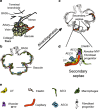Alveologenesis: key cellular players and fibroblast growth factor 10 signaling
- PMID: 27098664
- PMCID: PMC4840179
- DOI: 10.1186/s40348-016-0045-7
Alveologenesis: key cellular players and fibroblast growth factor 10 signaling
Abstract
Background: Alveologenesis is the last stage in lung development and is essential for building the gas-exchanging units called alveoli. Despite intensive lung research, the intricate crosstalk between mesenchymal and epithelial cell lineages during alveologenesis is poorly understood. This crosstalk contributes to the formation of the secondary septae, which are key structures of healthy alveoli.
Conclusions: A better understanding of the cellular and molecular processes underlying the formation of the secondary septae is critical for the development of new therapies to protect or regenerate the alveoli. This review summarizes briefly the alveologenesis process in mouse and human. Further, it discusses the current knowledge on the epithelial and mesenchymal progenitor cells during early lung development giving rise to the key cellular players (e.g., alveolar epithelial cell type I, alveolar epithelial cell type II, alveolar myofibroblast, lipofibroblast) involved in alveologenesis. This review focusses mainly on the role of fibroblast growth factor 10 (FGF10), one of the most important signaling molecules during lung development, in epithelial and mesenchymal cell lineage formation.
Keywords: Alveolar epithelial cell type I (AEC I); Alveolar epithelial cell type II (AEC II); Alveolar myofibroblast; Alveologenesis; Fibroblast growth factor 10 (FGF10); Secondary septae.
Figures

Similar articles
-
A three-dimensional study of alveologenesis in mouse lung.Dev Biol. 2016 Jan 15;409(2):429-41. doi: 10.1016/j.ydbio.2015.11.017. Epub 2015 Nov 26. Dev Biol. 2016. PMID: 26632490 Free PMC article.
-
A mammalian Wnt5a-Ror2-Vangl2 axis controls the cytoskeleton and confers cellular properties required for alveologenesis.Elife. 2020 May 12;9:e53688. doi: 10.7554/eLife.53688. Elife. 2020. PMID: 32394892 Free PMC article.
-
Acquisition of cellular properties during alveolar formation requires differential activity and distribution of mitochondria.Elife. 2022 Apr 6;11:e68598. doi: 10.7554/eLife.68598. Elife. 2022. PMID: 35384838 Free PMC article.
-
A breath of fresh air on the mesenchyme: impact of impaired mesenchymal development on the pathogenesis of bronchopulmonary dysplasia.Front Med (Lausanne). 2015 Apr 28;2:27. doi: 10.3389/fmed.2015.00027. eCollection 2015. Front Med (Lausanne). 2015. PMID: 25973420 Free PMC article. Review.
-
Divergent fibroblast growth factor signaling pathways in lung fibroblast subsets: where do we go from here?Am J Physiol Lung Cell Mol Physiol. 2015 Oct 15;309(8):L751-5. doi: 10.1152/ajplung.00298.2015. Epub 2015 Sep 4. Am J Physiol Lung Cell Mol Physiol. 2015. PMID: 26342090 Review.
Cited by
-
Elastin in pulmonary pathology: relevance in tumours with a lepidic or papillary appearance. A comprehensive understanding from a morphological viewpoint.Histopathology. 2022 Feb;80(3):457-467. doi: 10.1111/his.14537. Epub 2021 Sep 23. Histopathology. 2022. PMID: 34355407 Free PMC article. Review.
-
Transitional human alveolar type II epithelial cells suppress extracellular matrix and growth factor gene expression in lung fibroblasts.Am J Physiol Lung Cell Mol Physiol. 2019 Aug 1;317(2):L283-L294. doi: 10.1152/ajplung.00337.2018. Epub 2019 Jun 5. Am J Physiol Lung Cell Mol Physiol. 2019. PMID: 31166130 Free PMC article.
-
Delivery of FGF10 by implantable porous gelatin microspheres for treatment of spinal cord injury.Mol Med Rep. 2023 Jul;28(1):137. doi: 10.3892/mmr.2023.13024. Epub 2023 Jun 2. Mol Med Rep. 2023. PMID: 37264963 Free PMC article.
-
Intrauterine Hypoxia and Epigenetic Programming in Lung Development and Disease.Biomedicines. 2021 Aug 2;9(8):944. doi: 10.3390/biomedicines9080944. Biomedicines. 2021. PMID: 34440150 Free PMC article. Review.
-
The need for coordination of research activities in pediatric lung diseases.Mol Cell Pediatr. 2016 Dec;3(1):26. doi: 10.1186/s40348-016-0060-8. Epub 2016 Jul 27. Mol Cell Pediatr. 2016. PMID: 27465412 Free PMC article. No abstract available.
References
Publication types
Grants and funding
LinkOut - more resources
Full Text Sources
Other Literature Sources

